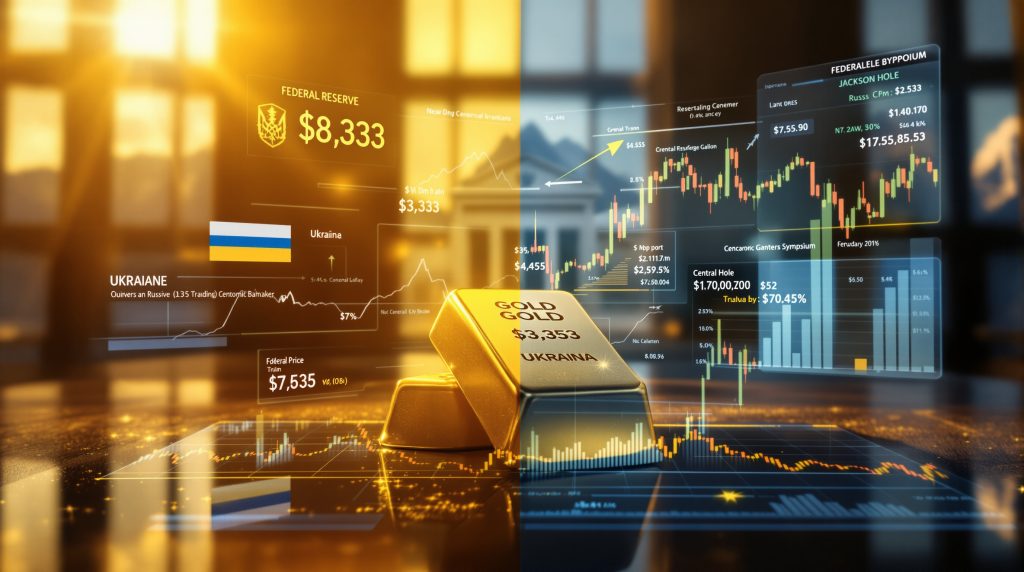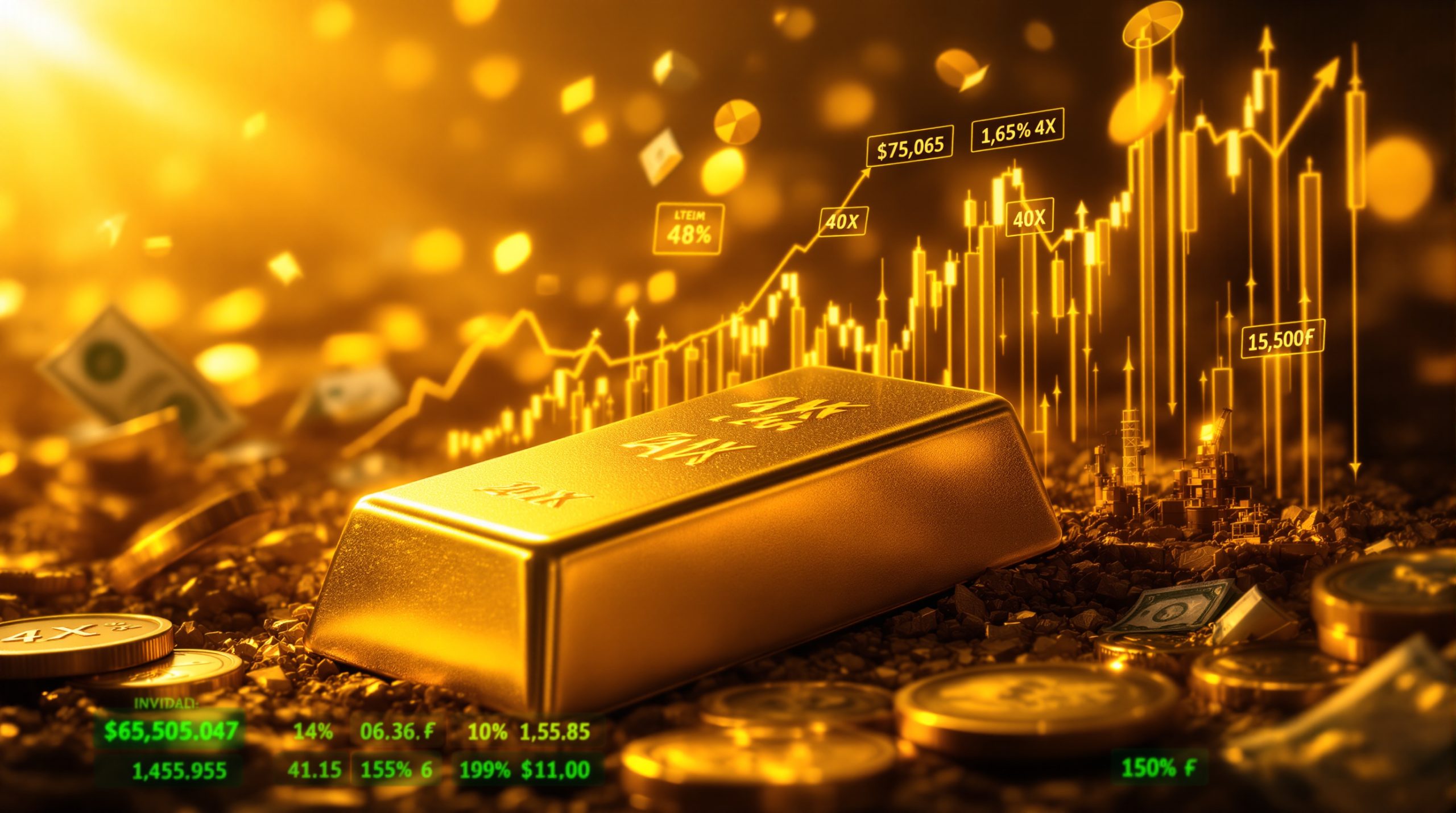Gold Price Wavers as Traders Look to Jackson Hole and Ukraine Talks
Gold prices have been exhibiting a curious sideways pattern in recent trading sessions, hovering around the $3,333 per ounce mark as investors carefully assess multiple influential factors. This consolidation comes after an impressive rally of approximately 25% year-to-date, with the precious metal reaching all-time highs analysis earlier in 2025. Market participants now find themselves at a critical juncture, balancing monetary policy expectations against evolving geopolitical developments.
The current trading range represents a natural consolidation phase following gold's remarkable ascent to all-time highs in April. Technical analysts point to decreasing volatility metrics and stable trading volumes as indicators of a market digesting recent gains while establishing new support levels. This pattern often precedes significant directional moves, particularly when major market-moving events approach.
Current Market Conditions Shaping Gold's Movement
Gold's recent performance has been influenced by several macroeconomic factors, including inflation trends, central bank policies, and global economic uncertainties. The Bloomberg Dollar Spot Index has recently climbed 0.2%, creating some headwinds for gold as the two typically move inversely to each other.
"Markets increasingly expect the Federal Reserve to strike a more dovish tone at the upcoming Jackson Hole symposium, with traders largely looking past last week's slightly firmer US inflation print," notes Priyanka Sachdeva, analyst at Phillip Nova Singapore. "The broader market view is that inflationary pressures remain on a cooling path."
This perspective aligns with gold's typical behavior during periods of monetary policy transitions, particularly when interest rate cuts appear on the horizon. Traders are carefully monitoring technical indicators for signs of directional breakouts from the current consolidation pattern.
How Jackson Hole Symposium Could Influence Gold Prices
The annual economic policy gathering in Wyoming has historically served as a platform for central bankers to signal important policy shifts. This year's symposium, beginning Friday, has captured extraordinary attention from precious metals investors looking for clues about the Federal Reserve's next moves.
Market participants have largely priced in expectations for a September rate cut, with the symposium potentially offering confirmation of this trajectory. Fed officials, including Raphael Bostic, have recently indicated openness to adjusting rates soon, citing concerns about economic pressures from import tariffs and the impact of elevated borrowing costs on business profitability.
The Interest Rate Factor in Gold Pricing
Gold traditionally benefits from lower interest rate environments for several key reasons. As a non-yield-bearing asset, gold becomes relatively more attractive when interest-bearing alternatives offer diminishing returns. The relationship between gold and real interest rates (nominal rates minus inflation) tends to be particularly strong.
When examining historical gold performance around Federal Reserve policy shifts, several patterns emerge:
- Gold often rallies in anticipation of rate cuts, sometimes months before actual implementation
- Price reactions to the first cut in a cycle tend to be more pronounced than subsequent reductions
- Market positioning ahead of expected policy changes can sometimes lead to "sell the news" reactions
Investors utilizing technical analysis are closely monitoring key support levels around $3,300 and resistance near the previous all-time highs, which could determine gold's next directional move following the symposium.
Geopolitical Factors Creating Market Uncertainty
While monetary policy developments occupy center stage, significant geopolitical events continue to influence gold's safe-haven appeal. The ongoing Ukraine-Russia conflict remains a major consideration, with recent diplomatic efforts introducing new variables into the market equation.
High-stakes discussions in Washington involving Ukrainian President Volodymyr Zelenskiy and European allies have generated speculation about potential conflict resolution pathways. Following recent summit meetings between key world leaders, markets have become increasingly sensitive to any signs of diplomatic breakthroughs.
Trade Tensions and Their Impact on Gold
Current trade tensions have contributed significantly to gold's appeal as a portfolio stabilizer. Economic pressures resulting from tariff implementations have been explicitly mentioned by Federal Reserve officials as factors influencing their policy considerations.
Trade conflicts typically impact gold through several channels:
- Supply chain disruptions contributing to inflationary pressures
- Economic growth uncertainties driving safe-haven demand
- Currency market volatility affecting gold's dollar-denominated pricing
- Central bank policy responses to trade-related economic challenges
These factors collectively strengthen gold's traditional role during periods of international trade frictions, particularly when combined with other sources of market uncertainty.
Economic Uncertainty Driving Safe-Haven Demand
Growth concerns across major economies have contributed to investor caution, benefiting precious metals markets. The combination of inflation trends, policy divergence among central banks, and currency market fluctuations has created an environment conducive to defensive positioning.
Institutional investors have notably adjusted their portfolios to accommodate these uncertainties, with gold allocations increasing among various types of money managers. This trend reflects broader concerns about economic stability and the search for portfolio diversification benefits.
Fundamental Drivers Behind Gold's 2025 Performance
Gold's remarkable performance in 2025 can be attributed to several fundamental factors working in concert. The rally of more than 25% year-to-date reflects a complex interplay of demand drivers, supply considerations, and broader economic conditions.
Central Bank Purchasing Trends
A significant contributor to gold's strength has been sustained purchasing activity by central banks worldwide. Monetary authorities have continued their multi-year trend of net gold accumulation, reflecting strategic diversification away from traditional reserve currencies.
This official sector demand provides crucial support for gold prices, particularly as it represents long-term strategic holdings rather than tactical trading positions. The steady accumulation by monetary authorities sends powerful signals about gold's enduring role in the global financial system.
Investment Demand Dynamics
Both institutional and retail investment flows have contributed to gold's upward trajectory in 2025. ETF holdings have seen notable inflows during periods of market uncertainty, while physical bullion purchases have remained robust across key consumption markets.
Portfolio allocation shifts have favored increased gold exposure, driven by:
- Concerns about traditional asset valuations
- Inflation-hedging strategies
- Increased volatility in equity markets
- Geopolitical risk management considerations
These investment flows create important price support mechanisms, particularly during periods when other demand categories might temporarily soften.
Inflation Considerations and Real Yields
Recent US inflation data showing moderating pressures has created an interesting dynamic for gold markets. While gold is traditionally viewed as an inflation hedge, its relationship with real yields (nominal yields minus inflation) often proves more influential for price direction.
The combination of cooling inflation and potential interest rate cuts creates a favorable environment for gold, as real yields typically decline in such scenarios. Forward-looking inflation expectations, as reflected in breakeven rates and inflation swaps, continue to influence market positioning in precious metals.
Performance Comparison Across Precious Metals
While gold has captured significant attention, the broader precious metals complex offers important insights into underlying market dynamics. Each metal responds differently to economic conditions based on its unique supply-demand fundamentals and usage patterns.
Silver Market Dynamics
Silver has demonstrated parallel strength to gold, currently trading around $38.03 per ounce. This performance reflects silver's dual nature as both a precious and industrial metal, benefiting from investment demand while also responding to manufacturing sector trends.
The gold-silver ratio analysis provides insights into relative valuation and potential trading opportunities. Historical patterns suggest this ratio tends to decrease during precious metals bull markets as silver typically outperforms gold in percentage terms during strong uptrends.
Platinum Group Metals
Platinum and palladium have shown divergent performance patterns, with platinum trading near $1,346.20 per ounce and palladium at approximately $1,133.75. These metals are heavily influenced by automotive industry demand, particularly for catalytic converter applications.
Recent price movements reflect:
- Shifting automotive production trends
- Changes in emission standards globally
- Supply constraints from major producing regions
- Investment interest relative to gold and silver
The transition toward electric vehicles creates evolving demand dynamics for these metals, with hydrogen fuel cell technologies potentially supporting long-term platinum demand despite declining internal combustion engine production.
Correlation Patterns Across Precious Metals
Understanding intermarket relationships provides valuable insights for portfolio construction and trading strategies. While precious metals often move together during major market events, significant divergences can occur based on metal-specific fundamentals.
These correlation patterns tend to shift during economic transitions, creating both challenges and opportunities for investors. Relative value propositions emerge when historical relationships temporarily break down, potentially signaling important market changes or trading opportunities.
Technical Indicators for Gold Investors to Monitor
Technical analysis provides crucial tools for navigating gold's price movements, particularly during consolidation periods like the current environment. Several key indicators merit special attention from investors seeking to anticipate potential breakout directions.
Key Price Levels and Patterns
Support and resistance zones around the current trading range provide important reference points for market participants. The consolidation pattern following April's all-time highs has established clear technical boundaries that will likely determine the next significant move.
Moving average relationships, particularly the 50-day and 200-day averages, offer insights into underlying trend strength. Volume patterns during the consolidation phase provide clues about accumulation or distribution activities by larger market participants.
Momentum indicators require careful interpretation in sideways markets, with divergence signals often preceding important price movements. The relative strength index (RSI) and moving average convergence divergence (MACD) frequently provide early warning signs of potential trend changes.
Seasonal Factors Affecting Gold
Historical performance patterns suggest late summer and early fall often represent important seasonal periods for gold markets. This timing coincides with traditional jewelry manufacturing cycles ahead of festival seasons in key consumption markets.
Trading volume patterns around the Jackson Hole symposium historically show increased activity as market participants position for potential policy signals. Year-end considerations also influence institutional positioning, creating recurring seasonal influences on price action.
Market Positioning Data
Futures market commitment of traders reports provide valuable insights into positioning by different market participant categories. Commercial hedgers, large speculators, and small traders often exhibit different behavioral patterns that can signal important market turns.
Options market sentiment indicators, particularly put-call ratios and volatility skew measurements, offer additional perspective on market expectations. ETF holdings and flow patterns reflect investment demand trends, while retail investor sentiment metrics help gauge public participation levels.
Potential Market Reactions to Peace Negotiations
Geopolitical developments, particularly potential peace talks related to ongoing conflicts, could significantly impact gold markets. Understanding possible reaction scenarios helps investors prepare for volatility surrounding diplomatic announcements.
Market Reaction Scenarios
Historical price movements during geopolitical de-escalation events show varying patterns depending on broader economic conditions. Short-term reactions typically involve decreased safe-haven demand, but longer-term implications depend on economic recovery prospects and monetary policy responses.
Risk asset correlation during conflict resolution periods often shows increased equity market strength coinciding with precious metals weakness. However, this relationship can be complicated by other factors like interest rate expectations and inflation concerns.
Trading strategies for different diplomatic outcomes might include:
- Hedging positions ahead of significant announcement dates
- Monitoring volatility indicators for potential trading opportunities
- Assessing spillover effects on currency markets that impact gold pricing
- Evaluating sector-specific implications within commodities markets
These approaches recognize the complexity of market responses to geopolitical developments, which rarely follow simplistic patterns.
Safe-Haven Demand Shifts
Reallocation patterns during risk-on market environments typically show movement away from defensive assets like gold toward growth-oriented investments. This shift can temporarily pressure gold prices despite otherwise supportive fundamental factors.
Alternative safe-haven assets competing with gold include certain currencies, government bonds, and occasionally cryptocurrencies, though these relationships evolve over time. Institutional positioning ahead of anticipated diplomatic breakthroughs often reflects sophisticated risk management approaches that can influence short-term price movements.
Gold Market Outlook: Frequently Asked Questions
Investors commonly seek guidance on several key questions regarding gold's prospects through the remainder of 2025. While definitive answers remain elusive given market uncertainties, examining competing factors provides valuable perspective.
What is the most likely direction for gold prices through year-end 2025?
Analysis of competing bullish and bearish factors suggests continued support for gold, though with potential volatility around key events. Bullish elements include anticipated interest rate cuts, continued central bank buying, and persistent geopolitical uncertainties. Bearish considerations include potential peace developments, dollar strength scenarios, and profit-taking after substantial year-to-date gains.
Expert price forecast insights vary considerably, reflecting the range of possible outcomes based on how key variables evolve. The most significant catalysts likely to trigger substantial price movements include Federal Reserve policy announcements, major geopolitical developments, and unexpected inflation data.
How does dollar strength affect gold's performance?
The inverse correlation between gold and the US dollar stems from gold's dollar-denominated pricing and the currency's competing safe-haven status. This relationship shows notable exceptions during periods of systemic stress when both assets can simultaneously attract demand.
Currency market outlooks for major pairs influence gold through their impact on the dollar index. Central bank policy divergence between major economies creates currency movements that indirectly affect gold pricing in various local currencies.
Trading strategies accounting for currency impacts often involve monitoring real yield differentials between economies, which influence both currency values and gold's relative attractiveness across markets.
What role does physical gold demand play in current pricing?
Asian market purchasing patterns, particularly in China and India, continue to influence gold's supply-demand fundamentals. Price sensitivity varies across different consumption segments, with investment demand typically more responsive to price changes than traditional jewelry markets.
The balance between jewelry and investment demand fluctuates with economic conditions and cultural factors. Seasonal influences affect physical consumption, with festival and wedding seasons in key markets creating recurring demand patterns that savvy investors monitor.
How might changing global trade patterns impact gold?
Protectionist policies typically enhance safe-haven demand for gold through several mechanisms, including increased economic uncertainty and potential inflationary pressures. Supply chain reconfigurations resulting from trade disputes can impact production costs across industries, contributing to broader economic concerns that benefit precious metals.
Regional economic impacts from trade disputes often trigger monetary policy responses that influence gold through interest rate and currency channels. Long-term structural shifts in international commerce may gradually alter gold's traditional stock market relationship, creating both challenges and opportunities for portfolio construction.
Looking ahead, traders are closely watching for signs of a potential historic surge explanation that some analysts have forecasted could push prices toward the $3,500 level by year-end, particularly if geopolitical tensions escalate or central banks accelerate their dovish pivot.
Disclaimer: The information provided in this article is for educational purposes only and should not be considered investment advice. Gold prices are subject to substantial volatility and unpredictability. Investors should conduct thorough research and consider consulting with qualified financial professionals before making investment decisions.
Looking to Capitalise on the Next Major ASX Mineral Discovery?
Discovery Alert's proprietary Discovery IQ model instantly notifies investors of significant ASX mineral discoveries, transforming complex data into actionable insights that could help you identify opportunities like those that delivered exceptional returns for companies such as De Grey Mining and WA1 Resources. Visit the Discovery Alert discoveries page to understand why major mineral discoveries can lead to substantial market returns and begin your 30-day free trial today.




